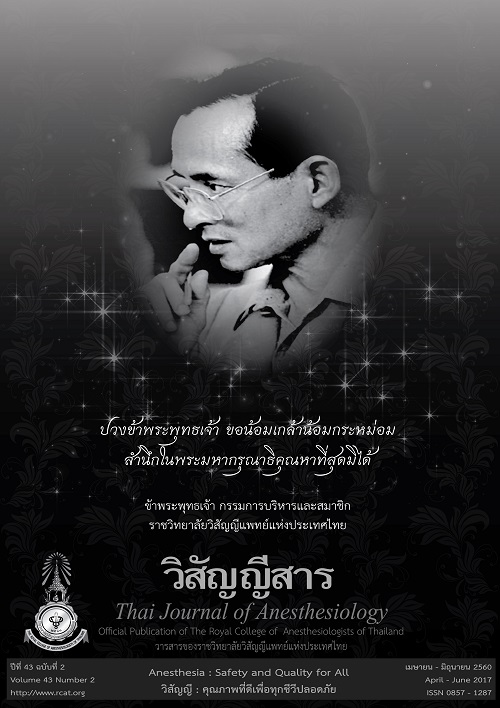Case report : Anesthetic management in 27-year-old woman with unruptured large cerebral aneurysm undergoing high-flow bypass with interposition graft
Main Article Content
Abstract
Background: In case of large or giant cerebral
aneurysms, patients usually present with good level
of consciousness and no neurological deficit. They
may require a bypass procedure to improve cerebral
blood flow during aneurysm management because
the aneurysms are too large to be clipped. High flow
bypass with interposition graft is the procedure that
the surgeon harvested vessel graft from other sites
or organs and use it to be a bypass for blood flow
across aneurysm. There are complications in this
procedure such as intraoperative aneurysm rupture,
massive hemorrhage, and cerebral ischemia, etc.
Neuroanesthetic goals in a high-flow bypass surgery
are to protect brain during temporary occlusion and
anastomosis, to increase ischemic tolerance, and to
prevent cerebral ischemia. Objective: To report a
case of anesthetic management in high flow bypass
with interposition graft in unruptured large cerebral
aneurysm. Methods: Medical and anesthetic records
were reviewed. The references were searched from
online literature. Results: A 27-year-old woman
presented with sudden severe left-sided headache
radiated to occipital area. She has no other neurological
deficit. Her MRI brain revealed partially calcified
P2 compartment of posterior communicating artery
aneurysm size 23x14 mm. She was referred to
Ramathibodi Hospital for further investigations
and planned for high-flow bypass surgery with
interposition graft. The patient was scheduled for
surgery. Arterial line was inserted into right radial
artery before induction. Central line was placed in
left internal jugular vein. Bispectral index (BIS) for
monitoring depth of anesthesia was established at
her forehead. We cooled the patient down at 33-34°C
via cooling mattress. When neurosurgeon was about
to perform temporary clipping of cerebral vessel,
we started thiopental continuous infusion with the
use of vasopressor to maintain adequate perfusion
pressure. After the completion of bypass procedure,
doppler ultrasound and intraoperative cerebral
angiogram were done to confirm good flow at
anastomotic sites. Finally, the patient was retained
endotracheal tube and transferred to the intensive
care unit (ICU). Five hours later, patient developed
left hemiparesis. The patient was immediately sent
to do the Computered Tomographic Angiography
(CTA). The CTA revealed total occlusion of
STA-P3 bypass and multifoci of intraparenchymal
hemorrhage with large surrounding edema. They
were results from bypass graft occlusion. However,
the patient had good consciousness and was
extubated at postoperative day 3. The motor weakness
was gradually recovered. Total length of hospital
stay was 19 days. Conclusion: Systemic mild
hypothermia and supplemental protective drug,
such as barbiturates may be used as the brain
protective strategies during high flow bypass in
unruptured large cerebral aneurysm.


